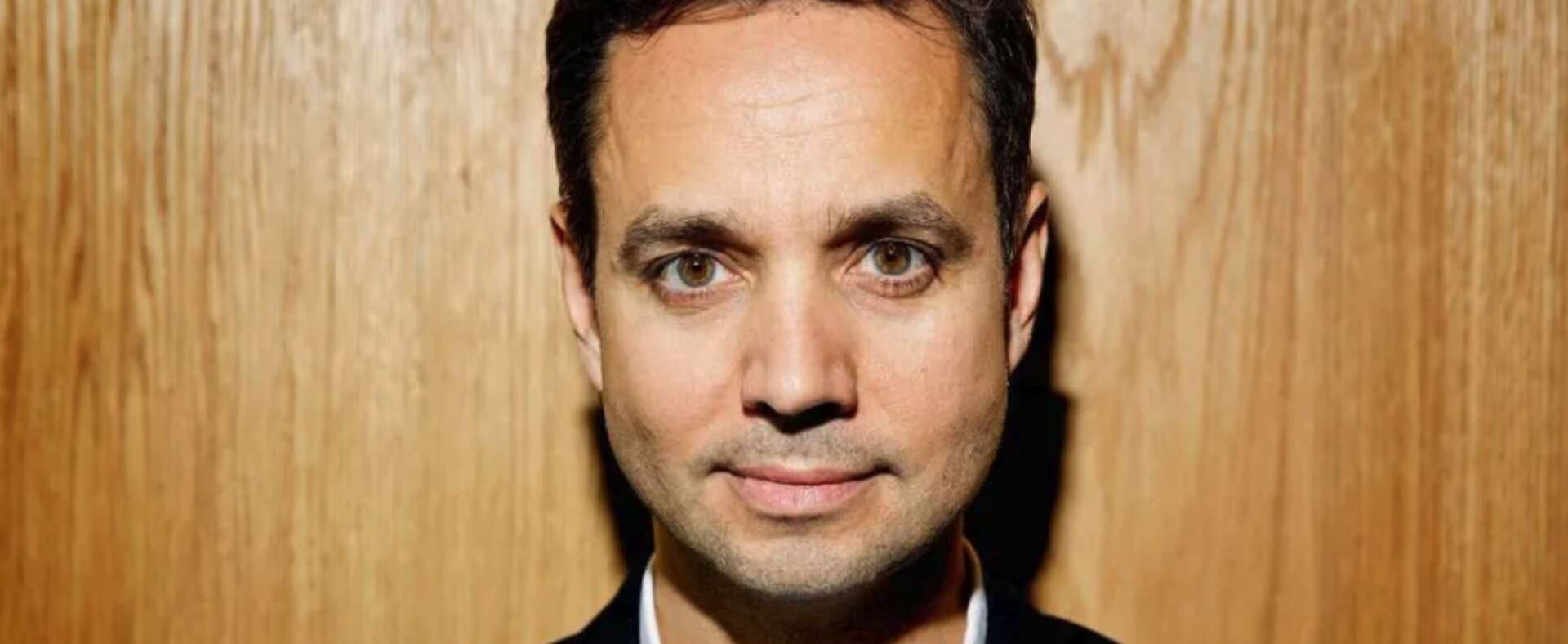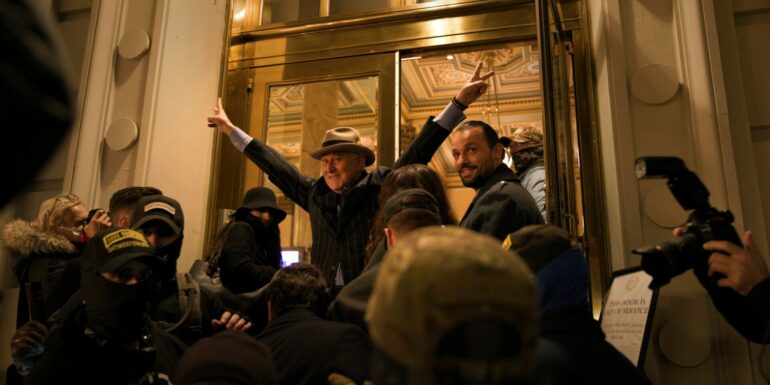
Filmmaker Christoffer Guldbrandsen and DoP Frederik Marbell open up about the long-awaited documentary A Storm Foretold which almost cost the director his own life.
“I’ve had a lot of difficult projects, but nothing as difficult, challenging and horrible as this one!” Guldbrandsen told us, ahead of the world premiere of his film in competition at CPH:DOX’s Dox:Award main competition March 17.
Trained as a journalist, Guldbrandsen is credited for widely debated films such as The Road to Europe
for which he collected a Cavling Prize nomination from the Danish Union of Journalists, The President (2011) and Stealing Africa (2012).
In his first film in tandem with cinematographer Frederik Marbell, Guldbrandsen has filmed for three years Donald Trump’s former advisor, the high-profile Republican Roger Stone, one of the instigators of the ‘Stop the Steal’ campaign in the US which culminated in the assault of the US Capitol January 6, 2021.
Even prior to the world premiere, footage from the film with some of the most controversial remarks by Stone (such as “F*ck the voting - let’s get right to the violence” uttered before the 2020 US elections) spread widely in the media, after Guldbrandsen was subpoenaed by the US January 6 Committee investigating the Capitol insurrection and asked to share some material.
The film opens and closes with the flamboyant Republic strategist Roger Stone, who famously carries a tattoo of Richard Nixon on his back, as he savours a cigar, in an attitude of self-contempt. For 90 minutes, the audience is taken to the heart of the pro-Trump and ‘Stop the Steal’ or ‘Make America Great Again’ movements, through the relentless campaigning and near-fall of Stone, suspected - but not convicted - of plotting the attack on Capitol Hill.
The filmmaking duo has followed the charismatic political strategist in his home in Florida, in his car (often driven by Guldbrandsen), heading to his numerous rallies, and at the events, where he exchanges discussions with leaders of far-right groups such as Proud Boys and the Oak Keepers, subsequently tried for seditious conspiracy.
The Danish filmmakers are also in the eye of the storm in Washington DC, on that very January 6, 2021 day, as pro-Trump voters turn into rioters and Stone decides to flee to Florida.
One of the film’s most harrowing moments is when Guldbrandsen himself becomes one of the collateral victims of Stone’s unpredictable behaviour. Suddenly ditched by the Trump long-term ally for another documentary crew, one year into filmmaking, the Danish director was the victim of a cardiac arrest at his gym, a tragic event captured by the gym’s security camera and inserted in the film. Guldbrandsen and Marbell were eventually able to carry on with their Stone portrayal. Today, the filmmakers and their main protagonist only communicate through their lawyers.
The film was produced by Guldbrandsen, Peter Engel and Henrik Veileborg, with co-financing from DR, SVT, NRK, Yle, ZDF/Arte, Film Fyn among others, support from the Danish Film Institute and Nordisk Film & TV Fond.
First of all, had you both worked together before this film and Frederik, at what point did you join the project?
Frederik Marbell: No. We had never worked together before this film. Christoffer had done some initial recording with Roger [Stone], and I joined the project in 2019. I have a background in postproduction as a freelancer, working on commercials and films. It’s been exceptional to follow the whole process of filmmaking here, and to be fully-invested.
Christoffer Guldbrandsen: First of all, our collaboration turned into a friendship and a creative partnership that I had never experienced before. It evolved into a method that I think we will continue with. We were basically partners in crime and worked together on all aspects of the production.
Could you take us back to the very first intention you had when you set out to make the film-was it because you wanted to shed a light on the dark forces in the US trying to shake democracy?
CG: Yes, but the approach changed. We set out with a very different story, a different plot but the same theme and Roger Stone was part of that story. As it evolved, we went for a real observational, fly-on-the-wall documentary which is what I love. It’s for me the best method in the genre.
Obviously, this type of film is a mirror of reality, an artistic interpretation of reality so you’re not able to script it in any way. We were challenged all the way by the political events, twists and turns. Having Frederik by my side was invaluable.
I’ve had a lot of difficult projects, but nothing as difficult, challenging and horrible as this one. Yet we’ve survived and we’re still here.
Can you expand? What made this project so dramatically more challenging than your earlier films?
CG: The first aspect was the financing of the film. We had to deal with a lot of rejection, unexpected rejections, and existential struggles. We couldn’t just wait until money would arrive; we had to get ahead and produce.
Then we had a character in Roger Stone, who was really difficult to grasp. He himself was under enormous pressure, so we had to adapt to his behaviour. After we had followed him for a year, one day he turned up with another film crew! He had sold the rights exclusively to make a documentary with them. That hit us exactly at the time when a very important piece of our financing was rejected, so the stress was tremendous. On top of that came Covid! We had an entire crew on contract who couldn’t work but was using the film budget that wasn’t financed.
FM: This is when Christoffer almost died…
CG: Yes. This is when I had a cardiac arrest. It was a very rough time.
How difficult was it to resume your collaboration with Stone after your serious health issues, as he had basically let you down and betrayed your trust?
CG: It was very challenging. He is averse to conflict and avoided discussing the topic. We had to manoeuvre and find a way around it. We were able to resume our collaboration with Roger because he was empathetic towards my health problems, but also because the other crew probably lost interest in the job when Roger was pardoned by Trump [after he was convicted of lying to Congress and obstructing a congressional investigation into Trump’s 2016 election campaign and possible ties to Russia].
Why do you think Roger Stone agreed to collaborate with you, although he doesn’t trust the media and has declined being interviewed by leading US media outlets, from CNN to the Washington Post?
FM: The first interview was quite easy to obtain. But then he was very hesitant to be part of an observational film. We had to do tons of interviews with him in staged situations, as this is the way he liked to be filmed and to keep control. But we haven’t used them in the film.
We probably got the access to him because we actually bonded, and he liked to have us around. He liked the exposure and the quality associated to a film like ours.
CG: It’s always transactional when you do a documentary with people in power. Here, Roger saw the potential for wide international exposure. If he ended up in prison [for his ties to the far-right movements and links to the Capitol attack on January 6, 2021], he would be immediately gagged and prevented from communicating. So he saw this as opportunity to keep being relevant.
Then there was a money side to it as well. He suggested to be paid for his participation. But he was pretty cool when we said we couldn’t and didn’t want to… until he went to other people who were ready to pay! In any case, these were his various motivations for doing this film with us.
On a different level, if you want to succeed in recording a main protagonist, there has to be a chemistry, a vibe. At our first meeting he kind of set the rules of engagement. He said he would be happy if the film ended up being 60% negative and 40% positive. This was quite an unorthodox approach.
Stone is altogether charming, entertaining, but also manipulative and a true bully, especially at the end when he is afraid to go to jail. We can see this in the extract when in the car, he yells at you: do I tell you how to make Danish films? No!! So don’t tell me about American politics!! It must have been unsettling…
CG: He does have a low impulse control. When he is upset he is very very upset and when he is happy he is very happy. He is human. We basically had to constantly adjust and translate when he would say: ‘I want to kill you’ (which he said to many people) into ‘I’m very upset’.
The film is a mix of fly-on-the-wall and participatory filmmaking. Christoffer why did you feel the need to be part of the story?
FM: I will answer here. It was actually a process. It took a long time to get Christoffer into the film, and it was part of the challenge of trying to solve the complexity of the narration. If we didn’t have Christoffer as kind of guide, the audience would have been a bit lost. We needed someone to take a handle of the story. And also, from a more cynical perspective, Christoffer decided to have a heart attack in from of the security cameras of the gym where he was training. So we wanted to use his presence in a different dramatic way.
CB: Being in front of the camera is not the way I’ve worked before, but it became necessary to make a fair portrayal of Stone. In the first 30 minutes of the film, he could be perceived as rather cynical. But his response to my cardiac arrest, open-heart surgery and near-death experience was one of empathy.
After that, his façade of cynicism got more nuanced and he started to get more human. We felt it necessary for the film to include that footage from the security cameras and for me to engage with Stone in front of the camera. But that wasn’t an easy decision for me. I’m a very private person and I’m uncomfortable being filmed.
Ultimately, the film is a critical approach to the Alt Right and Trump movement in the US. But it was important for us to make a human portrayal of Roger Stone. Too often we see films that turn populist people into cardboard cut outs of evil. I found it crucial to describe Stone as a human being in all his complexity.
How much footage did you end up with, how hard was it to find the core of the film, and who helped you with the editing?
FM: We ended up with 170 hours of material. It’s been a long process to make it easy for the audience to take in, because of the political context in the US and constant developments. For instance, we had the January 6 hearings of the US Congress where we did changes to the edit-then the week after there was a new hearing, with new details, where we could fine-tune the story. It is hard to plan anything with an observational doc.
CG: We had two fantastic editors working with us. The first editor was Andreas Jonsson Hay, a Swedish editor. He came to Copenhagen and we had a very inspiring collaboration. It was while working with that we got closer to the core of the film. Then time ran out and we got another editor Malene Dreyer. The universe of Roger Stone is very masculine, almost toxic. It was really nice to get her on board to get her perspective.
Did Stone try to stop you from making your footage available to the House select committee investigating the Capitol attack?
FM: We were in the US for the January 6 congressional hearings and now we’re communicating with Roger through lawyers. We had a signed contract so we’re protected.
How did you personally experience the historical January 6, 2021 - you Frederik filming Stone in the hotel room of the Willard Hotel in Washington [a place viewed by investigators of the Capitol riots as the command centre for Trump supporters before the attack] and you Christoffer on the ground at Capitol Hill?
CG: I was indeed at the Capitol. And Frederik wanted to be there with me, but he had to stay behind with Roger in his hotel room. I shot some of the footage at the Capitol, including someone slashing a reporter.
FM: It is difficult to explain how that crucial moment unfolded, because Roger acted in a super strange way. We were thrown out his hotel room right before the unrest started to unfold. When the news broke out about the riots at the Capitol, Christoffer and I split up. He went to film at the Capitol while I tried to get access to Roger’s room. His assistant kept me out, insisting he was taking a nap. To my luck, room service arrived and I snuck in with them and started filming. He couldn’t understand why I was filming him in his room when such dramatic events were happening. He was trying to downplay the significance of those events although in reality, he was one of the instigators of the ‘Stop the Steal’ movement that triggered the violence at the Capitol.
While those dramatic events were unfolding, his wish was to get out of Washington DC as soon as possible. He arranged for some rich donor to get a lift in a private jet to fly back to his home in Florida.
Talking about money, all through the film we can see how Stone is being handed cash by Trump supporters at the various meetings he attends…
FM: Yes everything is about money. When Roger claims ‘Stop the Steal’ at his rally, he immediately says “we’ve got to raise the money to stop the steal.
Having spent three years with Stone, one of Trump’s closest allies - and documented him and his friends contesting the 2020 election results through the ‘Stop the Steal’ campaign, what view do you have now of the dark forces of populism threatening democracy?
CG: It was a chance for us to look into the crystal ball, to see what’s ahead of us in Europe. We’re seeing the same move towards extreme right and threats to our democracies. I can’t predict the future. But there is nothing indicating that it won’t be much worse in Europe. There is no reconciliation, remorse.
FM: There is no accountability. After the January 6, 2021 Capitol attack, the only people who have been prosecuted are the people who were influenced by right wing politicians and were involved in the attack as they felt the elections were stolen from them. But the old politicians and those who truly responsible for the unrest were not held accountable.
How do you feel about Trump running for the 2024 elections and him claiming to those who felt the previous elections were stolen, “I am your retribution”?
CG: It’s a tragedy. It’s about US voters still looking for a strong man and who feel let down by the current government. History unfortunately is repeating itself in many ways.
You‘ve made some of your footage available to the January 6 US House select committee and some of your material was leaked to the Washington Post and CNN for their own reporting. Was that essential for you - and your own way to defend democracy?
CG and FM: Yes. We think so.
The film needs to be shown worldwide. What are the distribution plans?
CG: We’re still working on finishing the film and we haven’t focused on the distribution. But we’ve been fortunate to have great partners in DR, ZDF/Arte, RUV, SVT, Yle, NRK, VPRO to mention a few European pubcasters.
There isn’t a US distributor yet?
CG: No not yet. No one has seen the film yet.
How does it feel to have the world premiere at CPH:DOX?
CG: It’s a great platform and for us, having the film world premiering on European soil is very important. Our intention is to put up a mirror, to give an outside perspective on populism in the US that is relevant for us as Europeans, in the wake of the challenges that we’re facing here as well.

